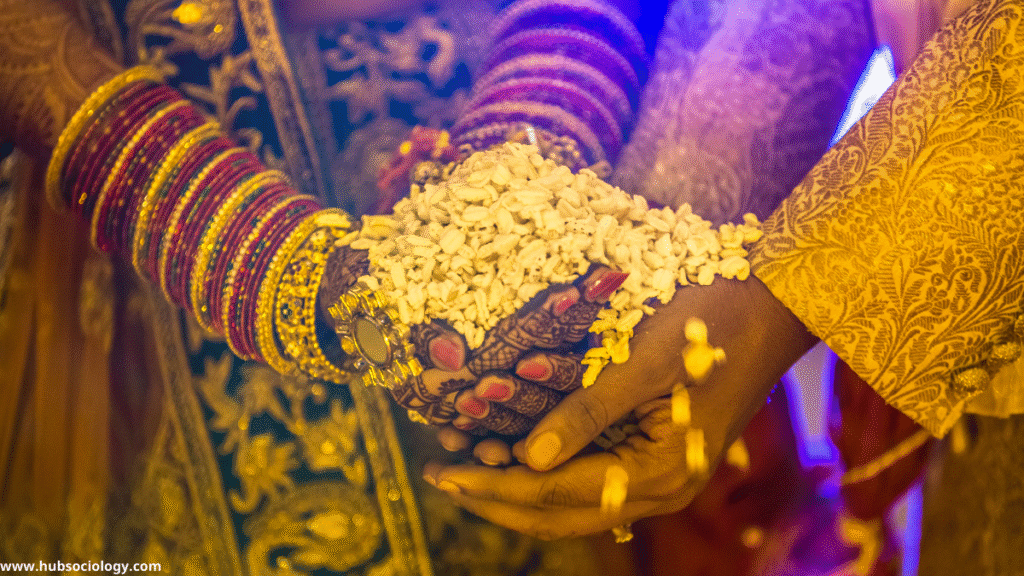Introduction on Monogamy and Polygamy Marriage
In India, marriage is a complicated social institution that is ingrained in the nation’s religious, cultural, and legal fabric. It is not just a union of two people. A fascinating sociological contradiction arises from the practices of polygamy (having multiple spouses at the same time) and monogamy (marrying one spouse at a time). While the law predominantly upholds monogamy, the shadows of polygamy linger, influenced by tradition, religion, and socio-economic factors. Understanding this duality offers a critical lens into the evolution of Indian society, the tension between modern law and traditional norms, and the persistent challenges related to gender justice.

Table of Contents on Monogamy and Polygamy Marriage
The Legal Framework: Mandating Monogamy, Permitting Exceptions

The most significant legal intervention shaping marital structures in modern India was the Hindu Marriage Act of 1955. This act was a revolutionary piece of social legislation that sought to reform Hindu personal laws. Among its key provisions was the enforcement of compulsory monogamy for all Hindus, Buddhists, Jains, and Sikhs. A Hindu marriage is now legally void if either party has a living spouse at the time of marriage. This marked a decisive break from the ancient practice of polygyny (a form of polygamy where a man has multiple wives), which was prevalent among certain sections of upper-caste Hindus.
However, India’s legal landscape is uniquely pluralistic. While monogamy is mandated for Hindus, personal laws for Muslims, based on the Shariat, permit polygyny—a man can have up to four wives, conditional on his ability to treat them all equally. This legal exception is a constant source of debate and is often misunderstood. It is crucial to note that this provision is not an injunction but a permission, and its practice is far from universal within the Muslim community.
Furthermore, Indian law also recognizes the customs of various tribal and indigenous communities across the country, some of which have traditional practices of polygyny or polyandry (a woman having multiple husbands, as historically practiced in parts of Himachal Pradesh and among the Toda tribe of Tamil Nadu). This legal pluralism creates a scenario where the ideal of a uniform civil code, as envisioned in the Directive Principles of the Indian Constitution, remains a contentious and politically charged goal.
Sociological Drivers of Polygamy: Beyond Religion
While religion provides the legal sanction for polygyny among Muslims, the sociological reasons for its persistence, as well as its historical practice among Hindus, are more nuanced and often intersect with economic and patriarchal structures.

- Patriarchy and Son Preference: In a deeply patriarchal society, the pressure to produce a male heir has been a significant historical driver of polygyny. If a first wife bore only daughters, a man might take a second wife in the hope of siring a son to carry on the lineage and perform last rites—a concept considered crucial in Hinduism. This reduced the woman to a instrument for procreation and reinforced her subordinate status.
- Socio-Economic Factors: In certain agrarian and feudal societies, having more wives (and consequently, more children) was seen as a source of economic wealth and labour. Multiple wives could manage a larger household and contribute to agricultural work, enhancing the family’s productivity and social standing.
- The Status Symbol: In traditional settings, the ability to support multiple wives was a sign of prosperity, power, and social prestige for a man. It was a public demonstration of his economic capability and masculine authority.
- Demographic and Post-War Scenarios: Sociologists also point to situations of gender imbalance. After wars or in communities with high male mortality rates, polygyny could serve as a social mechanism to ensure all women had the opportunity for marriage and social security within the confines of that societal structure, however inequitable.
For Muslims, while religious permission exists, the actual practice is declining rapidly due to modern education, economic constraints, and changing social norms. Supporting multiple families with equal justice is a daunting economic challenge for most men.
The Sociological Imperative for Monogamy
The shift towards legislating monogamy was driven by Enlightenment ideals of equality, individual rights, and dignity, which influenced India’s founding fathers. From a sociological perspective, monogamy was promoted as a cornerstone of a modern, progressive society for several reasons:
- Gender Justice: Monogamy is fundamentally aligned with the principle of equality between sexes. It challenges the patriarchal notion of women as property and advocates for a more balanced partnership within marriage. It aims to protect women from the exploitation, neglect, and emotional trauma often associated with polygynous arrangements.
- Modernization and Nuclear Family: The modern capitalist state thrives on the model of the nuclear family. Monogamy is seen as providing a more stable environment for raising children, with clear lines of inheritance and emotional investment from both parents. It aligns with the values of romantic love, companionship, and mutual support that characterize contemporary ideals of marriage.
- Individual Rights: The Hindu reforms of the 1950s were deeply focused on establishing the individual, particularly women, as a rights-bearing entity, separate from the traditional, patriarchal joint family structure. Enforcing monogamy was a direct attack on the customary privileges of men and a step towards establishing women’s rights to equality within marriage.
The Ground Reality of Monogamy and Polygamy Marriage
Despite the legal mandate, the practice of polygyny has not been completely eradicated among Hindus. It persists clandestinely, often through bigamous marriages that are not legally registered but are socially acknowledged within certain communities. Sociological studies indicate that economic deprivation and lower levels of education are correlated with a higher prevalence of such practices.
The existence of polygyny, both legal and illegal, highlights several enduring sociological issues:
- The Subordination of Women: In both scenarios, women often bear the brunt of the arrangement. They may face economic insecurity, emotional distress, and social stigma. Their agency in consenting to such marriages is frequently questionable, influenced by family pressure and a lack of alternatives.
- The Myth of Equal Treatment: The Islamic condition of equal treatment for all wives is, as many scholars argue, nearly impossible to fulfill in an emotional and psychological sense, making the practice inherently tilted towards injustice.
- The Class Divide: The practice of polygyny, whether among rich tribal chiefs, certain Muslim communities, or clandestinely among Hindus, is often tied to class. It is either a display of wealth or a strategy for economic survival, but rarely a choice made from a position of empowered equality.
Conclusion on Monogamy and Polygamy Marriage
The interplay between monogamy and polygamy in India is a microcosm of the larger society’s struggle to negotiate between tradition and modernity, uniform law and cultural pluralism, and patriarchal norms and the imperative of gender justice.
Legally, monogamy is the established norm for the vast majority of Indians, representing the state’s vision of a modern social order. Yet, the sanctioned exceptions and illicit practices reveal the enduring power of traditional social structures and deep-seated patriarchy. From a sociological standpoint, the mere existence of a law is insufficient to transform social reality. Change is a gradual process driven by education, economic empowerment of women, and a cultural shift towards seeing marriage as a partnership of equals.

The debate is no longer about the legality of polygamy for most Indians but about the quality and meaning of monogamous relationships themselves. As Indian society continues to evolve, the institution of marriage is being re-evaluated through the lenses of love, compatibility, and individual choice, moving slowly but surely away from its historical roots in social obligation, economic necessity, and patriarchal control. The tapestry of Indian marriage, therefore, remains in flux, woven with threads of ancient custom and modern law, reflecting the ongoing, dynamic transformation of the nation itself.
Do you like this this Article ? You Can follow as on :-
Facebook – https://www.facebook.com/hubsociology
Whatsapp Channel – https://whatsapp.com/channel/0029Vb6D8vGKWEKpJpu5QP0O
Gmail – hubsociology@gmail.com
Topic Related Questions on Monogamy and Polygamy Marriage
5 Marks Questions on Monogamy and Polygamy Marriage (Short Answer)
These questions require brief answers focusing on definitions, basic facts, and concise explanations.
- Define monogamy and polygamy. Briefly state the legal position of each for Hindus in India.
- What was the key provision regarding monogamy in the Hindu Marriage Act, 1955?
- Name two tribal communities in India known for their traditional practice of polyandry.
- List any two sociological reasons for the historical practice of polygyny in India.
- According to Islamic personal law in India, what is the primary condition for a man to practice polygyny?
10 Marks Questions on Monogamy and Polygamy Marriage (Detailed Answer)
These questions require longer answers that explain concepts, discuss reasons, and analyze interconnections.
- Discuss the role of patriarchy and son preference as sociological factors behind the practice of polygyny in India.
- “The Hindu Marriage Act, 1955 was a revolutionary piece of social legislation.” Explain this statement in the context of its provisions on monogamy.
- Analyze the socio-economic factors that have historically driven the practice of polygyny in certain sections of Indian society.
- Examine the reasons for the persistence of polygyny in India despite legal prohibitions for the majority of its citizens.
- Explain the concept of ‘legal pluralism’ in the context of marriage laws in India, using examples of monogamy and polygamy.
15 Marks Questions on Monogamy and Polygamy Marriage (Essay-type Answer)
These questions require comprehensive answers that include in-depth analysis, multiple perspectives, critical evaluation, and conclusions.
- Critically evaluate the sociological imperative for mandating monogamy in modern India. To what extent has this legal reform been successful in achieving its goals of gender justice?
- “The coexistence of monogamy as a legal norm and polygamy as a social practice highlights the tension between modern law and traditional norms in India.” Discuss this statement from a sociological perspective.
- Analyze the practice of polygamy in India as a site of gender inequality. Discuss how it impacts the social and economic status of women, both in communities where it is legally permitted and where it is practiced clandestinely.
- The debate on a Uniform Civil Code (UCC) often centers on the issue of marriage laws. Discuss the challenges and implications of formulating a uniform law on monogamy for a sociologically diverse country like India.
- Trace the evolution of the institution of marriage in India from a sociological standpoint, focusing on the shift from accepted polygamous practices to the establishment of monogamy as the dominant legal and social ideal.
